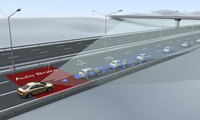Volvo helps prevent rear-end impacts
 Volvo continues to address the problem of rear-end impacts by introducing Collision Warning with Auto Brake, a warning system that automatically pre-charges the brakes if a rear end collision with a moving or stationary vehicle is imminent. This technology will be unveiled at the Frankfurt Motorshow on 11 September and will be introduced as an option along with Adaptive Cruise Control and Distance Alert. The option will cost £1,300 and will be available in the Volvo S80, V70 and XC701 at the end of 2007.
Volvo continues to address the problem of rear-end impacts by introducing Collision Warning with Auto Brake, a warning system that automatically pre-charges the brakes if a rear end collision with a moving or stationary vehicle is imminent. This technology will be unveiled at the Frankfurt Motorshow on 11 September and will be introduced as an option along with Adaptive Cruise Control and Distance Alert. The option will cost £1,300 and will be available in the Volvo S80, V70 and XC701 at the end of 2007. Enhanced technology
The new Collision Warning with Auto Brake enhances the Collision Warning with Brake Support that was introduced in 2006 and uses both radar and a camera to detect vehicles in front of the car. The radar has a range of 150 metres while the camera range is 55 metres. By combining the information from both the radar and camera the system becomes more efficient and with statistics showing that 50 percent of rear-end impacts involve a stationary object, the system can also detect stationary vehicles. The warning system can be adapted to match individual driving styles and conditions and can be changed in the car settings menu with a choice of three sensitivity options.
How it works
The system begins when the car is approaching another vehicle from behind and the driver does not react. To alert the driver a red warning light flashes in the head-up display on the windscreen and an audible signal can be heard. In many cases this gives the driver enough time to react and an accident can be avoided. If the risk of collision increases despite the warning, the brake support is activated. This shortens the reaction time by preparing the brakes by placing the brake pads against the discs. The brake pressure is also reinforced hydraulically, ensuring effective braking even if the driver doesn't press the brake pedal particularly hard.
If the driver still doesn’t brake and the sensor system determines that a collision is going to happen, the brakes are activated automatically. Auto Brake is designed to lower the impact speed as much as possible and thereby reduce the risk of injury to the occupants of both vehicles. For example a reduction in speed from 37mph to 31mph gives approximately 30 percent less impact energy, this can mean the difference between a serious and minor injury. In some cases it can help avoid the impact completely.
Keep your distance
To help maintain relaxed driving control Adaptive Cruise Control (ACC) is also included within this option; this system maintains a steady distance between the car in front even when traffic flow is uneven. By using radar sensors to continuously measure the distance to the vehicle in front, the system automatically adapts the speed of the car to ensure that the distance is maintained. Adaptive Cruise Control handles part of the routine driving functions so the driver can focus on what’s going on further ahead. There is a choice of five different time intervals ranging between 1 and 2.6 seconds.
Distance Alert (DA) is the final new feature included in this option. The system helps the driver maintain a safe distance to the vehicle in front even when Adaptive Cruise Control is not in use. Activated via a button on the centre console, the driver can choose between five settings, similar to that of the ACC. If the time gap to the car in front gets shorter than the selected speed, the driver gets visual information in the head-up display on the lower section of the windscreen.
The availability of these systems depends on the number and quality of visible road markings. Poor light, fog, snow and extreme weather conditions can make the system unavailable.

